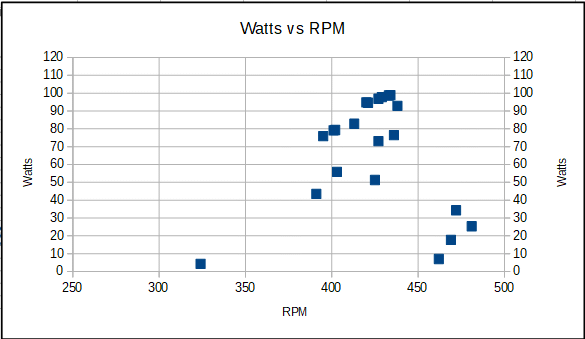Page 21– The Power Curve
You have taken a set of
readings, and entered them to a spread sheet.
The type
of chart you want to plot is shown on the right. Watts vs Rpm. A
“hilltop” chart.
When
an engine is running slowly, under heavy load, there is a good
time within each stroke
for the gas to be heated inside the
cylinder. The force of the rotating shaft is called the
torque.
The multiplication of the torque and the engine
speed, gives the engine power, the wattage.
“Power”
is the speed at which work is being delivered.
At low
revs the torque is good, but with low revs, the multiplication
yields a low power value.
If the load is lessened
slightly, the revs rise, but with less time in each engine
revolution,
there is slightly less time for gas to be heated
and slightly less torque is created.
However, the revs
have risen more than the torque has fallen. Multiplying, the power
rises.
Further loosening of the brake lowers the
friction and lets the engine run more rapidly.
Until the
point is reached when the drop in torque is balanced by the gain
in revs.
Hereafter, the reducing torque, or force per
revolution outweighs any increase in rpm.
The power
curve starts to descend.
If the brake clamp were
totally loosened, there would be no friction. The revs would soar.
Please do not
do this – over
revving engines destroy themselves.
But, IF,
the engine were running without load, then, whilst the revs would
be very high,
there is no load on the engine. There is no
torque being delivered.
The multiplication of high revs by
zero torque, is zero. The power is zero.
So the power
curve must come from zero – a stationary engine - then rise
to some peak,
and then fall away again – to zero –
when, with no load, no power is being delivered.
But does your chart look like this one below?
Read on...
What are all those low down points? What curve?